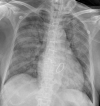Correlation of Chest X-Ray Scores in SARS-CoV-2 Patients With the Clinical Severity Classification and the Quick COVID-19 Severity Index
- PMID: 35702465
- PMCID: PMC9177221
- DOI: 10.7759/cureus.24864
Correlation of Chest X-Ray Scores in SARS-CoV-2 Patients With the Clinical Severity Classification and the Quick COVID-19 Severity Index
Abstract
Objectives This study aimed to assess the role of chest X-ray (CXR) scoring methods and their correlations with the clinical severity categories and the Quick COVID-19 Severity Index (qCSI). Methods We conducted a retrospective study of 159 COVID-19 patients who were diagnosed and treated at the University Medical Center between July and September 2021. Chest X-ray findings were evaluated, and severity scores were calculated using the modified CXR (mCXR), Radiographic Assessment of Lung Edema (RALE), and Brixia scoring systems. The three scores were then compared to the clinical severity categories and the qCSI using Spearman's correlation coefficient. Results Overall, 159 patients (63 males and 96 females) (mean age: 58.3 ± 15.7 years) were included. The correlation coefficients between the mCXR score and the Brixia and RALE scores were 0.9438 and 0.9450, respectively. The correlation coefficient between the RALE and Brixia scores was marginally higher, at 0.9625. The correlation coefficients between the qCSI and the Brixia, RALE, and mCXR scores were 0.7298, 0.7408, and 0.7156, respectively. The significant difference in the mean values of the three CXR scores between asymptomatic, mild, moderate, severe, and critical groups was also noted. Conclusions There were strong correlations between the three CXR scores and the clinical severity classification and the qCSI.
Keywords: brixia score; chest x-ray; chest x-ray (cxr); covid-19; covid-19 severity; rale score.
Copyright © 2022, Duc et al.
Conflict of interest statement
The authors have declared that no competing interests exist.
Figures




References
LinkOut - more resources
Full Text Sources
Miscellaneous
